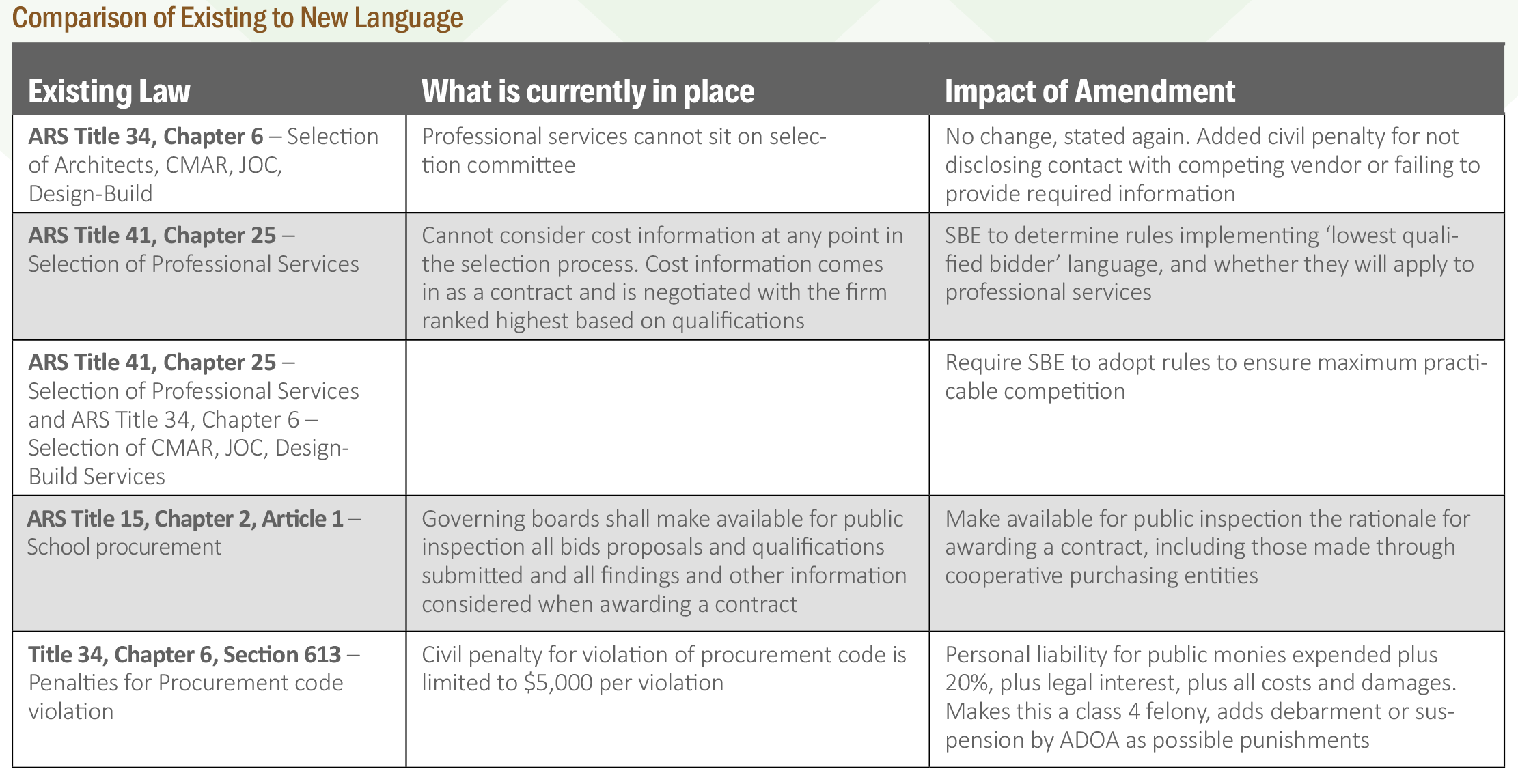By Rebekah Morris for Arizona Builder’s Exchange
Last month the Red for Ed budget bill caught the local building industry completely off-guard when it included a last-minute amendment that has far-reaching impacts on public K12 procurements. (AZBEX, May 8th)
This week I had the opportunity to sit down with the Speaker of the Arizona House of Representatives, JD Mesnard to discuss the impacts and origins of the amendment. He explained that the amendment, and the legislative arm in general, are very reactionary bodies, stating “There is a growing sentiment among legislators that the egregious procurement violations by Scottsdale (Unified School District) are not isolated, and that they will continue if we don’t do something.”
The amendment can be found here; the specific sections impacting procurements start at the bottom of page 5. Speaker Mesnard admitted that the amendment was brought forward in the last-minute chaos of passing the State budget, during the Red for Ed movement which saw tens of thousands of teachers march on the Capitol protesting low teacher pay. When asked if the industry was consulted about the language of the amendment, he admitted no, the voices he heard from objecting to it first were individual school districts. According to industry representatives, the amendment saw only 2:40 minutes of debate prior to passage.
How does the Amendment Compare to Existing Statute?
The jolt comes from the requirement to ‘award to the lowest qualified bidder’. That could mean either all Alternative Projects Delivery Methods contract types: CMAR, JOC, and Design-Build are eliminated, or the use of them must include a price component that determines the final award. It appears the existing two-step process of determining qualified firms proposing on a project might be able to meet that requirement, but the second step of considering price is the one that would ultimately determine the awardee.
Imagine a scenario where 15 firms submit statements of qualifications; 12 are found qualified on a pass/fail basis, the firm is either qualified or not qualified to perform the scope of work. All 12 then submit a price proposal, with the lowest price proposal being selected.
The State Board of Education rule making process will determine whether all APDM goes away or if any are still able to be used. It is entirely possible that all APDM will go away and construction will only be procured through a hard bid or design-bid-build process.
It is unclear whether Architectural and Engineering services would be procured through a lowest price method. According to Speaker Mesnard, that will be determined by the SBE’s rule making process as well. He initially said, “yes, design services would be included,” but then deferred to the SBE for implementation. Arizona State Board of Education Executive Director Alicia Williams concurred that full implementation comes out of a rule making process.
The effective date of the amendment is July 1, 2019, providing time for the SBE to solicit public input and proceed through the extensive rule making process outlined below.
Comparing to existing statute, there are items to be resolved, but the amendment doesn’t appear to flat out conflict with anything aside from the new requirement to use the ‘lowest qualified bidder’. Below are highlights comparing existing statute to the new language.
AZBEX NOTE: It is not our goal to identify every single impact, rather to bring forth highlights using simplified language that all our readers can understand. The amendment goes much further with impacts to the School Facilities Board and other educational programs that are specifically excluded from this discussion.

Impact to Design Firms
According to Katherine Dudzik Smith, AIA, AIA Arizona Government Affairs Chair, “At this time, there is no requirement that architectural or engineering services must be selected by lowest bidder in the new law; selection of professional services is defined elsewhere in existing Arizona law. However, this new law would affect any delivery method where the general contractor and the architect are under the same entity, such as Design-Build.”
Typically, in the public procurement process, a design firm is selected first, then participates in the selection of the General Contractor, sitting on the selection committee. That specific action of being disallowed from sitting on the selection committee has always been an existing statute. That would not be the only impact to design firms if the amendment takes effect as written, requiring districts to use a design-bid-build procurement.
In addition:
- Design will most likely take longer and needs to be fully developed prior to procurement of the General Contractor. Gone would be the days of design-assist from specialty contractors, and constructability reviews by General Contractors. The onus for 100 percent designed documents would fall squarely in the lap of the Architect/Engineer of Record.
- Prepare for litigation and claims to the Errors & Omissions E&O insurance policy. Low bid situations inherently increase the likelihood for claims and litigation by the Contractor. The design firm will be brought in to defend the quality of the documents over and over.
Impact to Cooperative Purchasing Entities & Job-Order Contracts
The requirement to use the lowest qualified bidder would impact existing cooperative contracts as well. During the due diligence process of the procurement, the cooperative has established the qualifications of contractors. Then, in theory, districts would be able to ‘bid’ the work to that list.
Job Order Contracts are currently delivered one of two ways:
- Price list + modifier – the selected contractor and the owner establish the scope of the project together, select the appropriate line items from a price book (RS Means book or similar) and use the already negotiated price modifier to produce the cost of the individual project.
- Open-book or Mini-CMAR – the selected GC produces a Guaranteed Maximum Price based on subcontractor quotes, letting the market dictate the cost of the project.
With the requirement to use the lowest bidder, delivering these JOC projects changes. During the initial contract negotiations, a low-price modifier can be the price determining factor. It is interesting to note that Arizona is the only state whose JOC legislation enables the open-book method. It’s unclear if the open-book or mini-CMAR method of JOC delivery would be able to continue.
SBE Rule Making Process
“The State Board of Education utilizes a rule making process prior to rule adoption by the Board. Typically, stakeholders are brought in to develop a draft rule. Then, that draft rule is presented to the Board, so that the Board can “open” the rule. Once a rule is open, Board staff collects public feedback on the draft rule. There is also a public hearing on the rule. Board staff then updates the Board at a second meeting on the draft rule and will collect additional public comments prior to “closing” the rule at the third meeting.
“This process usually takes three Board meetings, or 60 days, because the Board wants to ensure that there is ample time and opportunities for the public to comment on the rule. The public can comment and provide input during each of the Board meetings, through the Board’s inbox and at the public hearings.”
—Alicia Williams, Executive Director, State Board of Education.
We anticipate the industry will strongly fight the requirement to use the lowest qualified bidder as an across the board requirement. In addition, school districts impacted enjoy a range of procurement tools that will be greatly diminished and will join together to combat this requirement.
Obviously, we’ll continue to track this issue closely as the rule making process begins. We encourage you to get involved; whether you think this is a good idea or not, make your voice heard. Attend the public meetings and provide comments during the public comment period.
This is so important we want to get more information than what can be covered in written form. We want to ask questions of the right people who are involved in this process and top players in the market. To that end, we have reorganized our event programming and are bringing public K12 to the Leading Market Series monthly events on Thursday, July 12, 2018.

